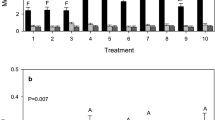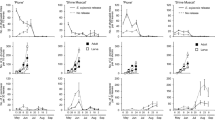Abstract
Sugarcane yellow mite, Oligonychus sacchari McGregor (Acari: Tetranychidae), is one of the most important sugarcane pests in Khuzestan province, southwest Iran. This mite directly damages leaf cells by sucking chloroplasts and weakens the plant. In this study, the effects of two sugarcane by-products including molasses, vinasse, and a commercial formulation, Bino2 were investigated against O. sacchari on sugarcane, varieties CP69-1062 and CP57-614, under field conditions. Population densities of different life stages of the mite including eggs, nymphs, and adults were recorded immediately after the application and 3, 7, 10, 14, 21, and 28 days after spraying. The results showed that the population density of different life stages of mite decreased over time after foliar application. The sugarcane molasses showed the most significant effect in controlling the population of the pest. After that, vinasse and Bino2 had appropriate acaricidal potential compared to the control. For the CP69-1062 variety, the mean population density of mites in the control treatment was 55 per leaf, and in molasses, vinasse, and Bino2 treatments was 6.48, 26.7, and 15.48 per leaf, respectively. For the CP57-614 variety, the mean population density in the control treatment was 75 per leaf, and in the molasses, vinasse, and Bino2 treatments was 5.88, 28.77, and 22.59, respectively. The highest amount of Brix, Pol, and Purity in two varieties CP69-1062 and CP57-614 was related to the molasses-treated plots. The molasses, vinasse, and Bino2 have appropriate acaricidal potential and can be used in sugarcane yellow mite management programs. However, more studies are required to confirm the findings.


Similar content being viewed by others
Data Availability
The authors declare that all data supporting the findings of this study are available in this manuscript.
Code Availability
Not applicable.
References
Ardeshir, Fariba, Gholam Ali Akbarzadeh Shokat, Davod Shirdel, and Hashem Kamali. 2018. Efficiency study of a new acaricide Kanemite 15% SC in control of European red mite in apple orchards. In Proceedings of the Third International Congress of Entomology, Tabriz University, Tabriz 85.
Assouguem, Amine, Mohammed Kara, Hamza Mechchate, Yesim Bulak Korkmaz, Safaâ Benmessaoud, Amal Ramzi, Khaled R. Abdullah, Omar Mohammed Noman, Abdellah Farah, and Abderahim Lazraq. 2022. Current situation of Tetranychus urticae (Acari: Tetranychidae) in Northern Africa: The sustainable control methods and priorities for future research. Sustainability 14 (4): 2395. https://doi.org/10.3390/su14042395.
Azaizeh, Hassan, M. Kobaisy, SBasharI. DakwarSaadShaqir, and Omar Said. 2007. Botanical pesticides as a source of safe bioacaricides for the control of Tetranychus cinnabarinus. Acta Phytopathologica Et Entomologica Hungarica 42 (1): 143–152. https://doi.org/10.1556/APhyt.42.2007.1.8.
Beard, Jennifer J., David Evans Walter, and Peter G. Allsopp. 2003. Spider mites of sugarcane in Australia: A review of grass-feeding Oligonychus Berlese (Acari: Prostigmata: Tetranychidae). Australian Journal of Entomology 42 (1): 51–78. https://doi.org/10.1046/j.1440-6055.2003.00326.x.
Biddinger, David J., Donald C. Weber, and Larry A. Hull. 2009. Coccinellidae as predators of mites: Stethorini in biological control. Biological Control 51: 268–283. https://doi.org/10.1016/j.biocontrol.2009.05.014.
Cheavegatti-Gianotto, Adriana, Hellen Marília Couto De Abreu, Paulo Arruda, João Carlos Bespalhok Filho, William Lee Burnquist, Silvana Creste, Luciana di Ciero, Jesus Aparecido Ferro, Antônio Vargas de Oliveira Figueira, Tarciso de Sousa Filgueiras, Mária de Fátima Grossi-de-Sá, Elio Cesar Guzzo, Hermann Paulo Hoffmann, Marcos Guimarães de Andrade Landell, Newton Macedo, Sizuo Matsuoka, Fernando de Castro Reinach, Eduardo Romano, William José da Silva, Márcio de Castro Silva Filho, and Eugenio César Ulian. 2011. Sugarcane (Saccharum X officinarum): A reference study for the regulation of genetically modified cultivars in Brazil. Tropical Plant Biology 4(1): 62-89. https://doi.org/10.1007/s12042-011-9068-3
Deka, Bhabesh, Azariah Babu, Chittaranjan Baruah, and Suman Sarkar. 2022. Plant extracts as potential acaricides for the management of Red Spider Mite, Oligonychus coffeae Nietner (Acarina: Tetranychidae), in the tea ecosystem: An eco-friendly strategy. Frontiers in Agronomy. https://doi.org/10.3389/fagro.2022.685568.
Gill, Harsimran Kaur, and Harsh Garg. 2014. Pesticide: Environmental impacts and management strategies. Pesticides-Toxic Aspects 8: 187.
Hamdi, Hassan. 2016. Sustainability in sugarcane production: Opportunities and limitations in Southwest of Iran. Sugar Tech 18 (6): 642–646. https://doi.org/10.1007/s12355-016-0493-3.
Hoarau, Julien, Yanis Caro, Isabelle Grondin, and Thomas Petit. 2018. Sugarcane vinasse processing: Toward a status shift from waste to valuable resource. A review. Journal of Water Process Engineering 24: 11–25. https://doi.org/10.1016/j.jwpe.2018.05.003.
IBM Corp. 2007. IBM SPSS Statistics for Windows Version 160. Chicago: IBM Corporation Spss Inc.
Karthick, K.S., T. Ramasubramanian, T. Kalyanasundaram, K. Devrajan, N.S. Venkataraman, and C. Chinniah. 2019. Efficacy of some acaricides against sugarcane web mite Schizotetranychus andropogoni Hirst. Indian Journal of Entomology 81: 651–655.
Lindquist, R., and M. Casey. 1990. Evaluation of oils, soaps, and natural product derivatives for leaf miner, foxglove aphid, western flower thrips, and greenhouse whitefly control. Ohio Florists’ Association Bulletin 727: 3–5.
Mohammadi, Somaieh, Masumeh Ziaee, and Ali Asghar Seraj. 2016. Sublethal effects of Biomite® on the population growth and life table parameters of Tetranychus turkestani Ugarov and Nikolskii on three cucumber cultivars. Systematic and Applied Acarology 21 (2): 218–226.
Nikpay, Amin, and François-Régis. Goebel. 2018. Field evaluation of sugarcane varieties against yellow mite Oligonychus sacchari McGregor (Prostigmata: Tetranychidae). Sugar Tech 20 (5): 613–616. https://doi.org/10.1007/s12355-017-0576-9.
Nikpay, Amin, and Henk-Maarten. Laane. 2020. Foliar amendment of silicic acid on population of yellow mite, Oligonychus sacchari (Acari: Tetranychidae) and its predatory beetle, Stethorus gilvifrons (Col.: Coccinellidae) on two sugarcane commercial varieties. Persian Journal of Acarology 9 (1): 57–66. https://doi.org/10.22073/pja.v9i1.55513.
Nikpay, Amin, and Ebrahim Soleyman-Nejadian. 2014. Field applications of silicon-based fertilizers against sugarcane yellow mite Oligonychus sacchari. Sugar Tech 16 (3): 319–324. https://doi.org/10.1007/s12355-013-0276-z.
Nikpay, Amin, Ebrahim Soleyman-Nejadian, Shila Goldasteh, and Hossein Farazmand. 2016. Efficacy of Biomite and GC-Mite on Oligonychus Sacchari and its predator Stethorus gilvifrons on sugarcane: Preliminary results. International Sugar Journal 118 (1410): 454–458.
Nikpay, Amin, and François-Régis Goebel. 2016. Major sugarcane pests and their management in Iran. In Proceedings of the International Society of Sugar Cane Technologists, Chiang Mai, Thailand 103–108.
Nikpay, Amin, Masoud Arbabi, and Morteza Kahrarian. 2012. Potential application of Neem-Azal against spider mite Oligonychus sacchari on two sugarcane commercial cultivars. In Proceedings of the 6th World Neem Conference, Nagpur/ India 69.
Oliveira, Maria De, Fátima. De Castro, Diego Pereira Santos, Karolline Sena Figueredo, Fabrício De Oliveira, Tiago Massi Reis, Heder Braun Ferraz, Eliemar Campostrini, and Fábio Afonso Mazzei Moura De Assis. Figueiredo. 2021. Production and quality of eucalyptus mini-cuttings using kaolin-based particle films. Journal of Forestry Research 32 (3): 953–965. https://doi.org/10.1007/s11676-020-01166-y.
Özkara, Arzu, Dilek Akyıl, and Muhsin Konuk. 2016. Pesticides, environmental pollution, and health Environmental health risk-hazardous factors to living species. London: IntechOpen.
Rezaei, Mehran, Saeid Moharramipour, and Mohammad Bashiri. 2017. September 2–4, 2017. Acaricidal effect of new botanical pesticide, Dayabon on Tetranychus urticae (Acari: Tetranychidae) and its predator, Stethorus gilvifrons (Coleoptera; Coccinellidae). In Proceedings of the Second International Congress of Entomology, Tehran University, Karaj 27.
Shukla, Abhishek. 2021. Mites 10. Polyphagous Pests of Crops: 409.
Silva, Amanda Cb, Adenir V. Teodoro, Eugênio E. Oliveira, Adriano S. Rêgo, and Rafael R. Silva. 2013. Toxicity of neem oil to the cassava green mite Mononychellus tanajoa (Bondar)(Acari: Tetranychidae). Chilean Journal of Agricultural Research 73 (3): 315–319. https://doi.org/10.4067/S0718-58392013000300016.
Singh, Manager, V.C. Jadaun, S.R. Singh, K. Lal, Atar Singh, and S.B. Singh. 2003. Chemical control of sugarcane yellow mite Oligonychus sacchari. Sugar Tech 5: 77–78. https://doi.org/10.1007/BF02943769.
Stoppok, Eberhard, and Klaus Buchholz. 1996. Sugar-based raw materials for fermentation applications. In Biotechnology: Products of Primary Metabolism, ed. H.J. Rehm and G. Reed, 4–29. New Jersey: Wiley Online Library.
Tomita, Masanori, and Hiroshi Endo. 2007. Using capsaicin as a less toxic insecticide. In Combined Proceedings International Plant Propagators' Society 728–732.
Vacante, Vincenzo. 2015. The handbook of mites of economic plants: identification, bio-ecology and control: Cabi.
Ziaee, Masumeh, and Amin Nikpay. 2016. Effect of mite damage on chlorophyll content of commercially cultivated sugarcane varieties using spad meter. Journal of Sugarcane Research 6 (1): 59–62.
Ziaee, Masumeh, Amin Nikpay, Pegah Koohzad-Mohammadi, and Solmaz Behnam-Oskuyee. 2017. The toxicity of Biomite®, GC-mite®, Oberon® and Envidor® acaricides against sugarcane yellow mite, Oligonychus sacchari (Acari: Tetranychidae). Persian Journal of Acarology 6 (2): 137–141. https://doi.org/10.22073/pja.v6i2.28024.
Acknowledgements
The authors are appreciated from Shahid Chamran University of Ahvaz for financial support [Grant Number: SCU.AP1400.104]. Special thanks to Raha Andish Kavan Company for providing Bino2 formulation.
Funding
This study was funded by Shahid Chamran University of Ahvaz, SCU.AP1400.104, Masumeh Ziaee.
Author information
Authors and Affiliations
Contributions
MB helped in visualization, methodology, data curation, MZ contributed to conceptualization, visualization, methodology, data curation, formal analysis, writing—original draft, FK performed conceptualization and visualization, FS was involved in conceptualization, writing—review & editing.
Corresponding author
Ethics declarations
Conflict of interest
The authors declare that they have no conflict of interest.
Additional information
Publisher's Note
Springer Nature remains neutral with regard to jurisdictional claims in published maps and institutional affiliations.
Rights and permissions
Springer Nature or its licensor (e.g. a society or other partner) holds exclusive rights to this article under a publishing agreement with the author(s) or other rightsholder(s); author self-archiving of the accepted manuscript version of this article is solely governed by the terms of such publishing agreement and applicable law.
About this article
Cite this article
Bavi, M., Ziaee, M., Kocheili, F. et al. The Effect of Two Sugarcane By-Products, and a Commercial Formulation, Bino2, Against Sugarcane Yellow Mite, Oligonychus sacchari (Acari: Tetranychidae). Sugar Tech 25, 717–726 (2023). https://doi.org/10.1007/s12355-022-01229-w
Received:
Accepted:
Published:
Issue Date:
DOI: https://doi.org/10.1007/s12355-022-01229-w




